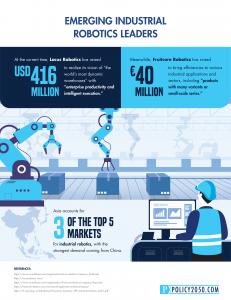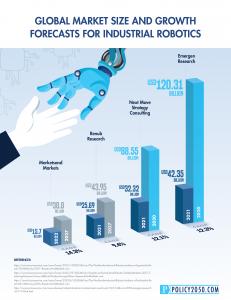Robotic Innovations and Public Policy: New Analysis Anticipates Global Changes
In the rise of robotics, Policy2050.com sees an unparalleled chance to inspire innovators and champion sustainability.
SAN FRANCISCO, CALIFORNIA, USA, September 4, 2023/EINPresswire.com/ -- In his classic science-fiction novel, Philip K. Dick whimsically, yet also bleakly, pondered, “Do Androids Dream of Electric Sheep?” The emergence of “dark warehouses,” which can operate without human input and at least theoretically with the lights turned off, might help lull androids to sleep – at least, after they’re done with their designated tasks of receiving, logging, storing, retrieving, and packing an increasing number of SKUs within shrinking delivery windows.
Today, innovators are dreaming of androids more intensely than ever. Therefore, the tech-focused research firm Policy2050.com produced a new analysis, a reflection of its Deep Tech memberships tier, to identify some of the most prominent trends and examine them through the lens of public policy.
The whitepaper “Robotics Trends (2023–2025)” delves into the societal impacts of robotics. As it turns out, the policy issues in play are more multifaceted than technological unemployment. In STEM education, robotics kits enhance the creativity, problem-solving, and critical thinking of young learners. In terms of the environment, robots can help humanity with our most dire challenges by monitoring ecosystems and climate conditions, supporting sustainable agriculture, and maintaining green infrastructure. In labor markets, robots could increase safety and streamline industrial workflows. Nevertheless, policymakers must anticipate and address issues such as job displacement, AI and robotics weaponization, and the need to preserve human agency and values.
Robotics and industrial experts interviewed for the analysis include David Reger, founder and CEO of NEURA Robotics; Rhonda Dibachi, founder and CEO of HeyScottie; and Richard S. Grossman, Andrews Professor of Economics at Wesleyan University. The report was authored by David Pring-Mill, founder of Policy2050.com, and Raymond Aguilar, a contributor at Policy2050.com.
Pring-Mill remarked on the whitepaper’s release: “Robots could be used to uphold human values, security, and well-being… or they could spell our destruction. It all depends on the strategies and frameworks we employ today.”
In an interview for the analysis, Richard S. Grossman, Andrews Professor of Economics at Wesleyan University, commented, “Technological improvements have been disrupting the workplace for centuries. Messengers on horseback were replaced by telegraph operators, who were replaced by telephone operators, who were replaced by automatic switchboards. Although each of these transitions benefitted some workers and made others worse off, in aggregate, the transitions have benefitted society.”
Those at the forefront of robotics developments have called for industry standards and regulations to counteract misuse. In an interview for the analysis, Rhonda Dibachi told Policy2050.com that from her industrial vantage point, a kill switch functions as a straightforward and separate safety measure, yet it’s also important to account for distributed liabilities within a broader framework. As Dibachi commented: “We used robots on our floor, and they all shared one thing: a kill switch. Just cut the power! AI-enabled robots I am sure will come with that feature, too. It’s easy, it’s low-tech, and it operates completely separately from any other part of the system.”
In another interview for the analysis, David Reger, founder and CEO of NEURA Robotics, said that the current hype around LLMs distracts from other challenges that must be navigated to realize AI and robotics on a global scale. This begins with raising the seemingly simple question of what activities a robot should – not can, he emphasized – perform. “Is it morally justifiable for a robot to take over the care of a senior citizen because people do not have the time or inclination to do so, or because society is not prepared to duly reward these healthcare activities?” Reger asked.
While robotics developments could mean economic turbulence, they may also help to weather literal storms by enabling more sustainable business practices or even monitoring and influencing environmental conditions. For instance, academic projects have leveraged biomimetics to emulate the form factors of nature, resulting in robots that are better positioned to glean data from real-world environments.
Aquatic or amphibious soft robots can mimic biological form factors – such as fish, mussels, lily pads, turtles, and stingrays – to sensitively navigate marine environments. Such applications can also track climate change-related data at great oceanic depths and sites, including trenches, underwater glacial walls, and marine microclimates, which would be inaccessible by other sensors or tracking methods. The robotic progress might even branch off to unrelated fields, such as healthcare, due to mind-boggling advancements, such as the integration of living cells into soft robotics.
With robots reporting from the scene, observing environmental impacts and fine-tuning predictive models, we could introduce new and improved metrics of political accountability. For example, the Thwaites Glacier in West Antarctica is responsible for roughly 4% of the overall sea level rise. Researchers used an underwater, cylindrical robot called Icefin to study the underside, and now we know that this so-called “Doomsday Glacier” is not just melting, it’s “shattering.”
On the land and in the skies, robots are being directed to optimize agriculture and infrastructure. This new era of robots will be designed to augment what we consider beneficial and deter what’s undesirable. As an example of the former, researchers have developed tiny robotic pollinators that can fly using wind and light. As an example of the latter, a Carbon Robotics unit can already destroy 100,000 weeds per hour. Meanwhile, the West Japan Rail Company is utilizing a crane arm with a robotic torso, mounted atop a service car, to maintain railway power lines, iterating upon its world-leading mass transit. Effective mass transit can cut local emissions in half, yet public transit is frequently neglected as a climate action policy measure.
The Policy2050.com whitepaper concludes with infographics that offer compelling visualizations of market dynamics, industry leaders, risks, and growth forecasts.
In a world captivated by gadgets and fleeting trends, the transformative power of Deep Tech is often overlooked. The road to a brighter, more advanced society is not a path of least resistance. Innovators are invited to join the Policy2050.com Deep Tech Membership. In so doing, they’re making a statement – that they choose substance over surface, innovation over imitation, and potential over precedent.
David Pring-Mill
Policy2050.com
david.pringmill@policy2050.com
Visit us on social media:
Twitter
LinkedIn
Legal Disclaimer:
EIN Presswire provides this news content "as is" without warranty of any kind. We do not accept any responsibility or liability for the accuracy, content, images, videos, licenses, completeness, legality, or reliability of the information contained in this article. If you have any complaints or copyright issues related to this article, kindly contact the author above.



